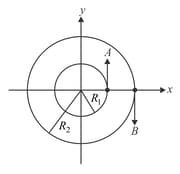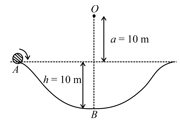MEDIUM
Earn 100
In the Southern Hemisphere, which direction does the Coriolis force deflect the wind?
(a)To the left
(b)To the right
(c)Upwards
(d)Downwards
50% studentsanswered this correctly
Important Questions on Mechanical Properties of Fluids
EASY
If the kinetic energy of a particle of mass performing uniform circular motion in a circle of radius is find the acceleration of the particle.
EASY
Two particles are moving on two concentric circles of radii and with equal angular speed At their positions and direction of motion are shown in the figure:

The relative velocity at is given by:
HARD
A particle of mass is released with an initial velocity along the curve from the point as shown in the figure. The point is at height from point The particle slides along the frictionless surface. When the particle reaches point its angular momentum about will be: (Take )

EASY
Why convection cannot take place in a solid?
EASY
State the unit and dimensions of coefficient of convection?
MEDIUM
It is hotter at the same distance over the top of a fire than it is on the side of it, mainly because :
MEDIUM
A liquid of mass m and specific heat c is heated to a temperature 2T. Another liquid of mass and specific heat 2c is heated to a temperature T. If these two liquids are mixed, the resulting temperature of the mixture is
EASY
In a place near the sea, a breeze blows from the sea to the land in the day time but it blows in the opposite direction at night. Why?
EASY
Permanent winds blowing toward the equator are called _____.
EASY
Assertion: It is hotter over the top of fire than at the same distance on the sides.
Reason: Air surrounding the fire conducts more heat upwards.
MEDIUM
Trade wind is an example of which of these?
MEDIUM
Ventilators are provided in rooms just below the roof. Why?
EASY
An ordinary electric fan does not cool the air; still, it gives comfort in summer. Explain.
EASY
Which method of heat transfer depends on gravity?
EASY
In which of the following process, convection does not takes place primarily?
EASY
The equatorial and polar regions of the earth receive unequal solar heat. The convection current arising due to this is called:
HARD
Explain how convection causes trade winds.
HARD
Explain the role of rotation of earth in the movement of trade winds.
HARD
In which of the following processes, convection of heat does not take place?
EASY
Two liquids and are at When mixed in equal masses the temperature of the mixture is found to be . Their specific heats are in the ratio of

